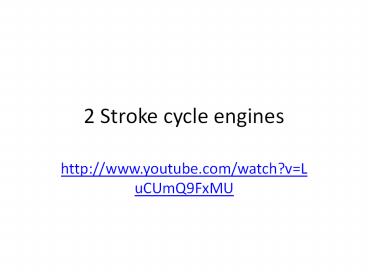2 Stroke cycle engines - PowerPoint PPT Presentation
1 / 16
Title:
2 Stroke cycle engines
Description:
2 Stroke cycle engine Mix special two-stroke oil in with the gasoline. Mix oil in with the gas to lubricate the crankshaft, connecting rod and cylinder walls – PowerPoint PPT presentation
Number of Views:167
Avg rating:3.0/5.0
Title: 2 Stroke cycle engines
1
2 Stroke cycle engines
- http//www.youtube.com/watch?vLuCUmQ9FxMU
2
2 Stroke Engine
- It's called a two-stoke engine because there is
a compression stroke and then a combustion
stroke. - In a four-stroke engine, there are separate
intake, compression, combustion and exhaust
strokes.
3
2 Stroke cycle engine
- Mix special two-stroke oil in with the gasoline
- Mix oil in with the gas to lubricate the
crankshaft, connecting rod and cylinder walls - Note If you forget to mix in the oil, the
engine isn't going to last very long!
4
Advantage
- Two-stroke engines do not have valves, which
simplifies their construction and lowers their
weight. - Two-stroke engines fire once every revolution,
while four-stroke engines fire once every other
revolution. This gives two-stroke engines a
significant power boost. - Two-stroke engines can work in any orientation,
which can be important in something like a
chainsaw. A standard four-stroke engine may have
problems with oil flow unless it is upright, and
5
Advantages
- These advantages make two-stroke engines lighter,
simpler and less expensive to manufacture. - Two-stroke engines also have the potential to
pack about twice the power into the same space
because there are twice as many power strokes per
revolution
6
(No Transcript)
7
Disadvantages
- Two-stroke engines don't last nearly as long as
four-stroke engines. The lack of a dedicated
lubrication system means that the parts of a
two-stroke engine wear a lot faster. - Two-stroke oil is expensive, and you need about 4
ounces of it per gallon of gas. You would burn
about a 3.7 litres of oil every 1600km if you
used a two-stroke engine in a car.
8
Disadvantages
- Two-stroke engines are not fuel efficient, so you
would get fewer miles per gallon. - Two-stroke engines produce a lot of pollution
- 1) from the combustion of the oil.
- 2) Each time a new charge of air/fuel is loaded
into the combustion chamber, part of it leaks
out through the exhaust port.
9
Exhaust
- Fuel and air in the cylinder have been
compressed, and when the spark plug fires the
mixture ignites. The resulting explosion drives
the piston downward. Note that as the piston
moves downward, it is compressing the air/fuel
mixture in the crankcase. As the piston
approaches the bottom of its stroke, the exhaust
port is uncovered. The pressure in the cylinder
drives most of the exhaust gases out of cylinder,
as shown here
10
Exhaust
11
Intake
- As the piston finally bottoms out, the intake
port is uncovered. The piston's movement has
pressurized the mixture in the crankcase, so it
rushes into the cylinder, displacing the
remaining exhaust gases and filling the cylinder
with a fresh charge of fuel, as shown here
12
Intake
- Note that in many two-stroke engines that use a
cross-flow design, the piston is shaped so that
the incoming fuel mixture doesn't simply flow
right over the top of the piston and out the
exhaust port.
13
Intake
14
Compression Stroke
- Now the momentum in the crankshaft starts driving
the piston back toward the spark plug for the
compression stroke. As the air/fuel mixture in
the piston is compressed, a vacuum is created in
the crankcase. This vacuum opens the reed
valve and sucks air/fuel/oil in from
the carburetor. - Reed valves are a type of check valve which
restrict the flow of fluids to a single
direction, opening and closing under changing
pressure on each face
15
Piston functions
- On one side of the piston is the combustion
chamber, where the piston is compressing the
air/fuel mixture and capturing the energy
released by the ignition of the fuel. - On the other side of the piston is the crankcase,
where the piston is creating a vacuum to suck in
air/fuel from the carburetor through the reed
valve and then pressurizing the crankcase so that
air/fuel is forced into the combustion chamber. - Meanwhile, the sides of the piston are acting
like valves, covering and uncovering the intake
and exhaust ports drilled into the side of the
cylinder wall.
16
(No Transcript)































